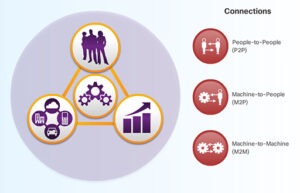Why Hybrid Work Can Become Toxic
Hybrid work, the blend of remote and in-office work, has become a popular model in the post-pandemic era, offering employees flexibility and autonomy. However, without careful management and clear boundaries, this seemingly ideal setup can morph into a toxic environment. The blurring lines between work and personal life, the potential for overwork due to the always-on culture, and the challenges in maintaining effective communication and team cohesion can all contribute to a stressful, unhealthy work atmosphere. Understanding these potential pitfalls is crucial for organizations aiming to harness the benefits of hybrid work while mitigating its potential downsides.

How Hybrid Work
In the modern era, the concept of hybrid work has gained significant traction. This model, which combines remote and in-office work, has become a beacon of hope for organizations seeking to adapt to the changing times. It offers a unique blend of flexibility and collaboration, allowing employees to enjoy the comfort of their homes while still having the opportunity to engage with their colleagues in a physical workspace.
The Rise of Hybrid Work
The advent of the COVID-19 pandemic served as a catalyst for the shift towards hybrid work. Companies, in a bid to maintain their operations amidst lockdowns and social distancing measures, had to embrace remote work. As the world began to adapt to this new reality, the benefits of working from home became increasingly apparent, leading to the rise of the hybrid work model.
Benefits of Hybrid Work
Hybrid work offers a plethora of advantages for both employees and employers. For employees, it eliminates the need for long commutes, provides a better work-life balance, and allows them to work in a comfortable and personalized environment. For employers, it reduces overhead costs, allows access to a wider talent pool, and can even increase productivity.
The Dark Side of Hybrid Work
However, like any work model, hybrid work is not without its pitfalls. If not managed properly, it can lead to a toxic work environment, negatively impacting employee morale and productivity.
Overworking and Burnout
One of the main issues with hybrid work is the blurring of boundaries between work and personal life. With the office just a few steps away, employees may feel compelled to work beyond their regular hours. This can lead to overwork and, eventually, burnout. The constant pressure to be available and the inability to disconnect from work can have serious implications for an employee’s mental and physical health.
Communication Challenges
Communication, a key element in any work environment, can become a challenge in a hybrid setting. The lack of face-to-face interaction can lead to misunderstandings and miscommunications. Moreover, employees working remotely may feel isolated or left out of important discussions, leading to feelings of alienation and decreased job satisfaction.
Lack of Work-Life Balance
Despite the promise of a better work-life balance, hybrid work can actually make it harder for employees to switch off from work. The constant availability and the inability to separate work from personal life can lead to increased stress and a lack of downtime.
Case Studies of Toxic Hybrid Work Environments
To better understand these issues, let’s delve into two case studies.
Case Study 1
Company A, a tech startup, embraced the hybrid work model without setting clear boundaries for their employees. This led to an expectation of constant availability, resulting in employees working long hours and experiencing high stress levels. Over time, this led to widespread burnout and a significant decrease in productivity and employee morale.
Case Study 2
Company B, a multinational corporation, also adopted a hybrid work model but struggled with communication. Employees working remotely often felt left out of important discussions and decisions, leading to feelings of isolation and decreased job satisfaction. This lack of effective communication led to a toxic work environment, with employees feeling undervalued and overlooked.
How to Prevent Toxicity in Hybrid Work
Despite these challenges, there are ways to prevent toxicity in a hybrid work environment.
Setting Boundaries
Companies should set clear boundaries to prevent overworking. This could include setting core working hours, encouraging employees to take regular breaks, and respecting their personal time. By doing so, companies can ensure that employees have the time to rest and recharge, thereby preventing burnout.
Effective Communication
Effective communication is key in a hybrid work environment. Regular check-ins, clear communication channels, and inclusive meetings can help prevent misunderstandings and feelings of isolation. By fostering an open and inclusive communication culture, companies can ensure that all employees feel valued and heard.
Prioritizing Employee Well-being
Lastly, companies should prioritize employee well-being. This could include offering mental health support, encouraging regular breaks, and promoting a healthy work-life balance. By prioritizing employee well-being, companies can create a positive work environment that fosters productivity and job satisfaction.
FAQs
What is hybrid work?
Hybrid work is a blend of remote and in-office work.
Why can hybrid work become toxic?
If not managed properly, hybrid work can lead to overworking, communication challenges, and a lack of work-life balance.
How can companies prevent toxicity in hybrid work?
Companies can prevent toxicity by setting clear boundaries, communicating effectively, and prioritizing employee well-being.
What are the benefits of hybrid work?
Hybrid work offers benefits such as flexibility, cost savings, and access to a wider talent pool.
What are the challenges of hybrid work?
Challenges of hybrid work include overworking, communication challenges, and a lack of work-life balance.
Conclusion
While hybrid work offers many benefits, it’s important to be aware of the potential pitfalls. By setting clear boundaries, communicating effectively, and prioritizing employee well-being, companies can create a healthy and productive hybrid work environment.













Post Comment